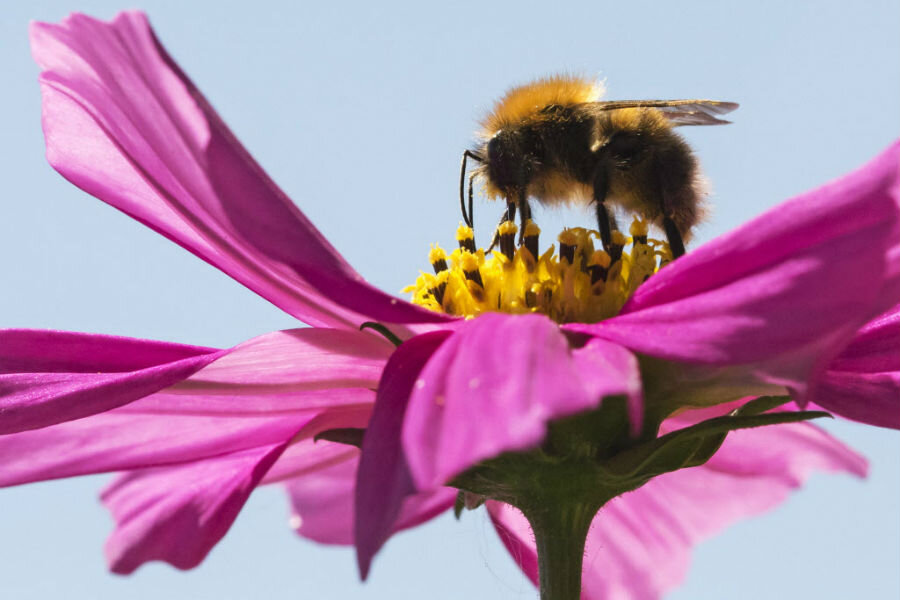How bees are getting a boost around the world
Loading...
According to the U.N. Food and Agriculture Organization (FAO), approximately 80 percent of all flowering plant species reproduce with the help of pollinator animals like bees, butterflies, birds, and more. This accounts for at least one third of the world’s food crops, including tomatoes, pepper, strawberries, coffee, apples, carrots, almonds, cocoa, and thousands of others.
Without pollinators, most plants could not produce fruits and seeds, and agricultural biodiversity would suffer--according to FAO, bees, bats, birds, and other pollinators, increase global food production by 87 percent. Unfortunately, the world is seeing a decline in pollinator populations. From land-use change and pesticide use to monoculture agriculture and climate change, there are numerous threats to pollinator populations.
That’s why gardeners, farmers, governments, and companies are finding innovative ways to protect wild pollinators and improve cultivation of commercial pollinators.
Last year, Australian father and son Stuart and Cedar Anderson invented a new bee hive design that allows beekeepers to harvest honey without disturbing bees. The Honey Flow is uniquely designed with a partial honeycomb frame and a specialized built-in tap that carefully extracts the honey and allows it to drain directly out of the hive, leaving the bees to continue their work.
This method is easier and safer for amateur beekeepers, but it is also a much less stressful method of honey collection for bees. Excess stress on bee colonies can make them more vulnerable to disease. The simple hive can also help attract more small-scale hobby beekeepers instead of large-scale commercial apiaries. Independent hives can boost local crop fertilization and improve genetic diversity of bees by reducing the chance of mites or viruses spreading between colonies in close proximity.
In The Gambia, an organization called BEECause is working to reverse the decline of bee populations. BEECause has trained hundreds of people to keep bees and make beeswax products, and their Bees for Trees program establishes self-supporting bee reserves in community-managed sustainable forests.
The European Union has made sweeping changes to protect bees from toxic insecticides. In 2012, the European Food Safety Authority assessed the effects of several neonicotinoids on bee populations. They subsequently banned the use these pesticides in agriculture.
In Latin America, the Mexican NGO Pronatura is working to preserve wild and cultivated plant species that feed bees. They work with local producers in these efforts, and they also carry out conservation projects such as restoring wild forests and protecting mangroves and other ecosystems.
Urban beekeeping is becoming more popular across the world. In Japan, the Ginza Honeybee Project relies on volunteers to harvest honey from rooftop hives in the Ginza district of Tokyo. The organization also lobbies to increase the planting of nectar-rich flowers in the city. And hives are also a teaching tool for elementary school students who take field trips to see the bees in action. The honey is used by local bakeries, hotels, bars, and other companies.
Promoting pollinator health is an issue of global importance, but individuals have the power to help in small ways in backyards or community spaces. Here are four things you can do to attract and protect pollinators, according to the U.S. Forest Service.
- Plant native species. Pollinators have evolved alongside native plants, so they are best adapted to feed on these species. Non-native plants often don’t have enough nectar or pollen. As an added bonus, native plants typically require less water, so they are easier for gardeners to maintain. When choosing species, opt for a diverse selection of plants with different flowering times so that flowers are blooming throughout the growing season, rather than all at once. Consult native plant guides in your region to determine which plant species attract certain types of pollinators.
- Avoid the use of chemicals. Many pesticides, herbicides, and fungicides are harmful to pollinator species. Use compost as a natural fertilizer, weed by hand, and look for non-chemical treatment methods to take care of pest infestations.
- Provide a welcoming environment. When planting your garden, arrange each species in large patches so that pollinators can forage more efficiently. Avoid the use of weed cloth or heavy mulch, as many native bee species nest underground. Provide habitat for pollinators by making piles of branches to attach chrysalises or cocoons. Leave stumps, rotting logs, and fallen organic material for nesting bees. Let dead or dying trees remain standing for woodpeckers.
- Educate your community. Share what you know about pollinator health and encourage schools, businesses, and public parks to make their green spaces pollinator-friendly.
This article first appeared at Food Tank.





